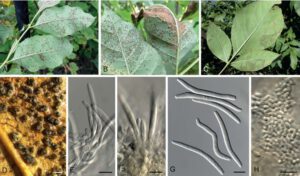Neoacervuloseptoria fraxini (Crous & Bulgakov) fraxini (Crous & Bulgakov) Raghv. Singh & Sanjay Yadav, in Yadav, Singh, Verma, Singh & Kushwaha, Mycol. Progr. 22(4, no. 26): 9 (2023)
Index Fungorum Number: IF 840503, MycoBank Number: MB 840503, Facesoffungi Number: FoF 15858
Basionym – Acervuloseptoria fraxini Crous & Bulgakov, Fungal Syst. Evol. 6: 175 (2020).
Description – Leaf spots hypophyllous, brown, 1–5 mm diam., appearing as small specks on the leaf near nerves, later merging. Conidiomata pycnidial, intermingled among spermatogonia on leaves, 200–250 µm diam, black, aggregated in dense clusters, opening via central ostiole; wall of 3–6 layers of brown textura angularis. Conidiophores reduced to conidiogenous cells lining the inner cavity. Conidiogenous cells subcylindrical to ampulliform, hyaline, smooth, 6–10 × 3–4 µm, proliferating percurrently and sympodially at apex. Conidia solitary, subcylindrical, hyaline, smooth, granular, straight to curved, apex subobtuse, base truncate with basal marginal frill, medianly 1-septate, (45–)52–58(–60) × 4(–5) µm.
Culture characteristics – Colonies erumpent, with sparse aerial mycelium and smooth, lobate margin, reaching 5 mm diam after 2 wk at 25 °C. On MEA, PDA and OA surface and reverse cinnamon, but with diffuse scarlet pigment on OA.
Typus – Russia, Rostov region, Shakhty city district, trees near Atyukhta river, on living leaves of Fraxinus pennsylvanica, 7 Oct. 2018, T.S. Bulgakov, HPC 2609 = Myc-45 (holotype CBS H-24228, culture ex-type CPC 36558 = CBS 145992).
Notes – Acervuloseptoria was established with the type species A. ziziphicola Crous & Jol. Roux (Crous et al. 2014). Only three species names are validly accepted in Acervuloseptoria (https://www.mycobank.org, queried 8 December 2021). In Videira et al. (2017), A. ziziphicola (CBS 138009) formed a sister lineage of Cercosporella based on LSU-RPB2 sequence data, while it clustered among the Cercosporella species based on LSU-RPB2-ITS sequence data. In 2020, A. fraxini Crous & Bulgakov (CPC 36558) was inferred as a relative of A. ziziphicola based on LSU-RPB2 sequence data (Crous et al. 2020). According to Crous et al. (2020), A. fraxini does not show morphological similarity with A. ziziphicola but was tentatively maintained in Acervuloseptoria. In this study, based on both datasets, A. fraxini clustered apart from A. ziziphicola (Figs. 1 and 2). Acervuloseptoria ziziphicola has acervular conidiomata that are black, erumpent and multilocular; their upper layer disintegrates upon maturity (Crous et al. 2014). Conidiomata in A. fraxini are pycnidial (thus, not acervular), have a central ostiole and are intermingled among spermatogonia (Crous et al. 2020). Therefore, a new genus Neoacervuloseptoria is to be introduced for the strain CPC 36558 in the Mycosphaerellaceae. Acervuloseptoria ziziphicola separated as a sister lineage of Neocercosporella with high bootstrap support (BI-PP/ML-BS/MP-BS: 1/100/100) (Figs. 1 and 2). The differences in morphology are significant enough to retain Acervuloseptoria (a coelomycete) as distinct from Neocercosporella (a hyphomycete). No molecular sequence data is available for A. capensis (G. Winter) Crous (Crous et al. 2015).

Figure 1 – Neoacervuloseptoria fraxini (CPC 36558). A–C. Disease symptoms on Fraxinus pennsylvanica. D. Conidiomata. E, F. Conidiogenous cells. G. Conidia. H. Spermatia. Scale bars = 10 µm.
